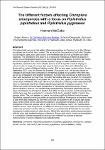The different factors affecting Chiroptera emergences with a focus on Pipistrellus pipistrellus and Pipistrellus pygmaeus
| dc.contributor.author | McCabe, H. | |
| dc.date.accessioned | 2023-12-22T15:29:23Z | |
| dc.date.available | 2023-12-22T15:29:23Z | |
| dc.date.issued | 2023 | |
| dc.identifier.citation |
McCabe, H. (2023) 'The different factors affecting Chiroptera emergences with a focus on Pipistrellus pipistrellus and Pipistrellus pygmaeus', The Plymouth Student Scientist, 16(2), pp. 285-313. | en_US |
| dc.identifier.uri | https://pearl.plymouth.ac.uk/handle/10026.1/21836 | |
| dc.description.abstract |
Chiroptera (bats) are important within different ecosystems and biomes due to the different ecosystem services that they provide. The services that they provide to the United Kingdom include organic agricultural pest control and worldwide bats provide pollination and seed dispersal. The rationale for this study is to understand emergence preferences based on natural and anthropogenic factors such as building structure, habitats, and time. Bat roosts are species specific, with urban exploiter species relying on urban habitats such as Pipistrellus pipistrellus and urban-adapter species such as Nyctalus noctule relying on natural roosts. A range of surveys sites were studied across, Hampshire Berkshire and Surrey with a variety of different habitats studied. Bat surveys were carried out from June to September 2021 using the Elekon Bat Scanner (Ecosupport, n.d.). All surveys lasted an average of two hours with extensions or shortenings judged on bat activity within the area, as well as temperature and weather conditions. Surveys were carried out at both dusk and dawn with sunset and sunrise times recorded. Secondary data was provided by Ecosupport and extracted and analysed from phase two bat reports, with specific locations and building names kept confidential. Although different urban features of buildings were measured there were no statistically significant results regarding bat species emergence locations. This differs from much of the literature studied due to Pipistrellus pipistrellus being a known crevice dweller. However, one similar study concluded that Pipistrellus pipistrellus did not have a preference on emergence location but rather on size of crevice used to emerge from. Habitat type was also investigated to evaluate if bats had a selected habitat of which they emerge within. The only species to have a conclusive significant habitat to emerge were Pipistrellus pipistrellus emerging within an agricultural habitat. Emergence and re-entry times of bats were also measured by the times of sunset and sunrise to see if natural light would have a direct effect on this. Sunset times did have a significant correlation to times of first emergence of total bat species with a higher level of confidence past 21:00. Sunrise times however did not have a significant correlation on re-entry times for total bat species when an outlier was removed from the data set. This study concludes that British bats do not prefer emergence location based on urban factors. Pipistrellus pipistrellus prefers agroecosystems with the other bats studied having no preference. Future work would include an investigation of a corelation between temperature emergences in British bat species to discuss improvements in bat box mitigation and manufacturing. | en_US |
| dc.language.iso | en | en_US |
| dc.publisher | University of Plymouth | en_US |
| dc.rights | Attribution 3.0 United States | * |
| dc.rights.uri | http://creativecommons.org/licenses/by/3.0/us/ | * |
| dc.subject | Chiroptera | en_US |
| dc.subject | Pipistrellus pipistrellus | en_US |
| dc.subject | Pipistrellus pygmaeus | en_US |
| dc.subject | emergence | en_US |
| dc.subject | habitats | en_US |
| dc.subject | sunset | en_US |
| dc.subject | sunrise | en_US |
| dc.subject | pest control | en_US |
| dc.subject | bioindicators | en_US |
| dc.subject | populations | en_US |
| dc.subject | crevice dwellers | en_US |
| dc.subject | roosts | en_US |
| dc.title | The different factors affecting Chiroptera emergences with a focus on Pipistrellus pipistrellus and Pipistrellus pygmaeus | en_US |
| dc.type | Article | en_US |
| plymouth.issue | 2 | |
| plymouth.volume | 16 | |
| plymouth.journal | The Plymouth Student Scientist |




